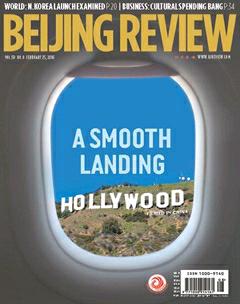Spring Festival In New York
By+Corrie+Dosh
Fireworks, fine arts and a day off school welcomed the Lunar New Year in New York City this year, as thousands of local children participated in an educational day at the Javits Center to learn about the Year of the Monkey.
“Fantastic Art China” was the headline event for the citywide festival on February 6-10, organized by institutions such as the U.S.-China Cultural Institute, Committee of 100, and New York Philharmonic. The 72,000-square-foot exhibition at the citys convention center was presented by the China Central Academy of Fine Arts (CAFA) to showcase new and exciting contemporary artists from China such as Pan Gongkai, Su Xinping, Jiang Jie and Duan Haikang. Opening the art show was a performance by iSING!—a student opera group led by opera superstar Haojiang Tian.
“We are delighted to partner with so many important New York cultural institutions to celebrate the 2016 Lunar New Year and Year of the Monkey. We hope that the Lunar New Year is not only a Chinese holiday, but also a global one. We hope the events of this five-day festival will provide a view of the future direction of modern Chinese arts, culture, and conservation,” said Yu Ding, Director of the CAFA Institute of Arts Administration and Education and Chief Curator of Fantastic Art China.
Highlights presented at the show included Pans Melt—a 72-foot-long video installation focused on the relationship between Chinese and Western art. Jiangs March Forward! March Forward! featured 1,000 dance shoes sculpted into a large cone to portray the hidden emotions and memories of youth. At the entrance to the exhibition towered Duans Golden Monkey Celebrating Spring, a 3,000-pound steel monkey riding a magical cloud. Birds, Insects, and Turtles entertained visitors through an interactive ancient scroll that included two digital apps to learn more of the natural behaviors and voices of the birds and insects presented.
In addition to presenting works from established artists, Fantastic Art China featured works by art students from around the country focused on issues of common interests, conflict and dialogue.
Public school holiday
For the first time, more than 1.1 million students at New York public schools received a day off to celebrate the Lunar New Year—the largest school district in the country to close for the holiday. About one sixth of New York City public schoolchildren are of Asian descent, according to the Associated Press.
A public school holiday for the Lunar New Year, which fell on February 8 this year, is “long overdue,” said Debbie Wiengraf, 36, of Brooklyn, told Beijing Review.
“I dont know much about Chinese New Year but Im glad to see the kids have the day off and a chance to celebrate it,” Wiengraf said.“Its an opportunity for my kids to learn about a different culture.”
To celebrate the inaugural public school holiday, a special New York City Lunar New Year Students Day was held featuring an opening ceremony, live acts and monkey dances taught by the National Dance Institute. The Nature Conservancy presented education on the endangered golden monkey of China and environmental protection.
“The celebration of the Chinese Lunar New Year is no longer a purely Chinese event but an occasion that celebrates the diverse cultures that make up our communities today,” said Shirley Young, Chair of the U.S.-China Cultural Institute.
Additional events to celebrate the Year of the Monkey included a fireworks spectacle over the Hudson River accompanied by a soundtrack by Oscar and Grammy award-winning composer Tan Dun. Coordinating the fireworks display was an Empire State Building light show that saw the shadow of a monkey atop New Yorks iconic skyscraper.
Classic grandeur
The New York Philharmonic on February 9 rang in the Lunar New Year with the premiere concert of Nu Shu—The Secret Songs of Women symphony for 13 “micro films” by composer Tan. The composer blended his signature compositions with an exploration into 700 years of native language and calligraphy used by women from a village in his native Hunan Province.
The haunting and drifting songs presented in Tans micro films were offered without subtitles or texts, giving the audience an emotional feeling of loneliness and loss—a nod to the ethereal and fading beauty of a history becoming lost to time.
“The slow disappearance of the Nu Shu tradition and culture has troubled me for many years,” Tan told The Washington Post. “I wanted to do the field research, anthro-musicological studies, collect the songs of Nu Shu and eventually compose a new symphonic concerto piece for the world and for my home village, to continue the tradition and to create a future from the past.”
Other works presented had a more festive tone. Li Huanzhis Spring Festival Overture opened the evening with a celebration of Chinese folk music, and The Butterfly Lovers by Chen Gang and He Zhanhao translates traditional Chinese music into Western orchestration. Violinist Maxim Vengerov imitated the sounds of a traditional erhu with “silky glissandos, and evoked the extravagant vocal swoops of Chinese opera with graceful portamentos,”The New York Times reported.
It was the philharmonics fifth year of celebrating the Lunar New Year with pieces by Chinese composers. The orchestra also offered a free outdoor event before the concert featuring the Nai-Ni Chen Dance Co. and public school students from the National Dance Institute performing Chinese folk dances.

